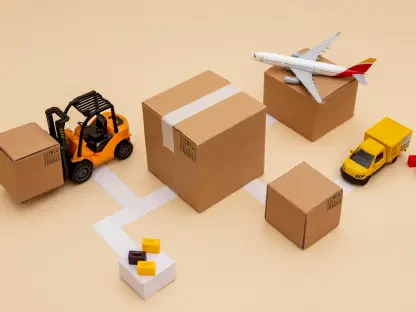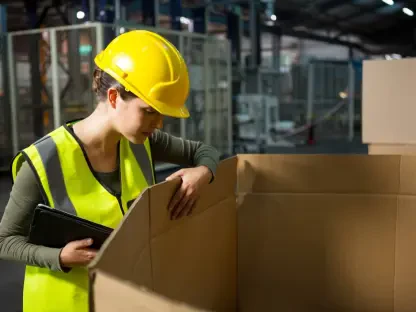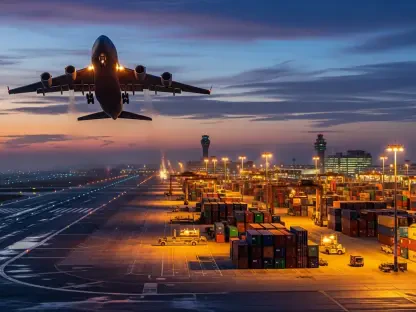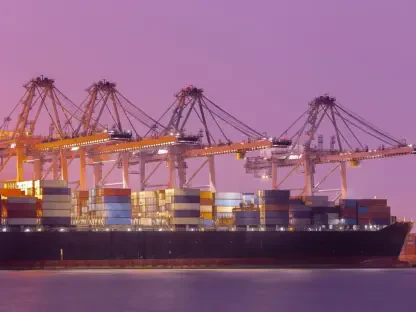In the fast-paced world of e-commerce, where same-day delivery has become a benchmark and order volumes continue to skyrocket, logistics providers face an unprecedented challenge to keep up with demand while maintaining precision and efficiency. Imagine a warehouse capable of handling thousands of diverse orders daily, with minimal human intervention, ensuring that every carton is stored, retrieved, and shipped with pinpoint accuracy. This is no longer a futuristic vision but a reality brought to life by cutting-edge automated carton warehouse technology. This review delves into a remarkable implementation by Arnulf Betzold GmbH, in collaboration with FORTNA, to explore how such systems are transforming intralogistics and setting new standards for scalability in the logistics sector.
Introduction to Automated Carton Warehouses
Automated carton warehouses have emerged as a cornerstone of modern intralogistics, addressing the pressing needs of e-commerce by streamlining storage and retrieval processes. These systems utilize advanced robotics, software integration, and conveyor technologies to manage vast inventories with speed and accuracy, significantly reducing the reliance on manual labor. Their role is pivotal in an era where consumer expectations for rapid delivery and diverse product availability are at an all-time high, pushing companies to rethink traditional warehousing models.
The rise of these technologies is closely tied to the explosive growth of online shopping, which demands greater efficiency and adaptability to fluctuating market trends. As order sizes shrink and frequency increases, traditional warehouses struggle to cope without significant delays or errors. Automated carton warehouses offer a solution by optimizing space utilization and throughput, ensuring that businesses can scale operations without compromising on service quality.
Positioned within the broader landscape of warehouse automation, this technology represents a critical evolution in logistics solutions. It aligns with other innovations like autonomous mobile robots and AI-driven inventory management, collectively reshaping how goods are handled from inbound to outbound stages. The focus on automation reflects a strategic shift toward building resilient supply chains capable of meeting modern challenges head-on.
Key Features of Betzold’s Automated Carton Warehouse
High-Capacity Storage Design
At the heart of Betzold’s automated carton warehouse lies an impressive structural design tailored for maximum storage efficiency. With four aisles and a staggering 80,000 storage locations, the system dramatically expands the company’s capacity to handle a growing inventory of teaching and learning materials. This setup is particularly crucial in the DACH region, where demand for specialized educational products continues to rise, necessitating robust storage solutions.
A key performance metric of this design is its ability to achieve 520 double cycles per hour, a figure that underscores its high operational throughput. This rate ensures that cartons are moved in and out of storage at a pace that keeps up with the rapid order turnover typical of e-commerce environments. Such efficiency minimizes bottlenecks, allowing for smoother workflows even during peak demand periods.
The impact of this high-capacity design extends beyond mere numbers, as it enables Betzold to manage a diverse range of products without sacrificing space or speed. By leveraging vertical and horizontal storage optimization, the system sets a benchmark for how automated warehouses can redefine capacity constraints. This approach serves as a model for other companies aiming to modernize their logistics infrastructure.
Advanced Automation and Integration Technologies
Delving into the technological backbone of Betzold’s warehouse reveals a fully automated incoming goods process that exemplifies precision and innovation. Equipped with OCR vision systems, the setup scans and identifies cartons seamlessly, while AI-supported error correction ensures accurate classification based on volume and weight. This reduces human oversight to a minimum, with only oversized or exceptionally heavy items requiring manual handling.
Equally significant is the integration of a new warehouse control system (WCS) with the existing warehouse management system (WMS), creating a cohesive framework for material flow. This synergy optimizes storage location selection and order batching, ensuring that retrieval processes are both dynamic and efficient. The result is a streamlined operation where every carton’s journey through the warehouse is meticulously orchestrated.
This level of automation and integration not only boosts operational accuracy but also lays the groundwork for scalability. By connecting advanced technologies with established systems, Betzold demonstrates how automation can enhance rather than disrupt existing workflows. Such advancements highlight the potential for technology to transform even the most complex logistics challenges into manageable, efficient processes.
Industry Trends Driving Warehouse Automation
The surge in e-commerce has reshaped the logistics landscape, with consumers increasingly expecting faster deliveries and a broader range of products. This shift toward smaller, more frequent orders has placed immense pressure on warehouses to adapt, driving the adoption of automation as a means to maintain competitiveness. Automated carton warehouses, like Betzold’s, are at the forefront of this transformation, addressing the need for speed and precision in order fulfillment.
Emerging trends further emphasize technology’s role in meeting heightened customer expectations. Innovations such as real-time inventory tracking and predictive analytics are becoming standard, enabling warehouses to anticipate demand spikes and adjust operations accordingly. These developments are pushing companies to invest in systems that not only handle current volumes but also prepare for future growth in order complexity and volume.
Across the industry, the move toward automation reflects a broader recognition that manual processes are no longer viable in a hyper-competitive market. Solutions like Betzold’s carton warehouse are becoming a blueprint for others, illustrating how technology can bridge the gap between rising demand and operational capacity. This trend signals a fundamental shift in logistics, where automation is no longer an option but a necessity for survival.
Real-World Applications and Impact
Betzold’s automated carton warehouse serves as a practical example of technology’s transformative power in the teaching and learning materials sector within the DACH region. By deploying this system, the company has significantly enhanced its ability to manage a diverse inventory tailored to educational needs, ensuring that orders are processed with exceptional speed and accuracy. This application highlights how automation can address niche market demands effectively.
The operational impact is evident in the system’s ability to handle complex order structures while maintaining scalability. With seamless integration to existing shuttle and high-bay warehouses, the setup facilitates efficient replenishment processes, ensuring that inventory levels remain optimized across all storage units. This interconnected approach minimizes downtime and maximizes resource utilization, a critical factor in e-commerce logistics.
A standout feature of this implementation is its adaptability to varying order profiles, a challenge many traditional warehouses struggle to overcome. By automating the majority of storage and retrieval tasks, Betzold has positioned itself to respond swiftly to market changes, reinforcing its leadership in the region. This real-world case underscores the tangible benefits of automation in enhancing both efficiency and strategic flexibility.
Challenges and Limitations in Adoption
Implementing an automated carton warehouse, while transformative, comes with notable challenges, starting with the substantial initial investment required. For many companies, the cost of such systems can be a significant barrier, necessitating careful financial planning and justification of long-term benefits over short-term expenses. Betzold’s journey reflects this reality, requiring a strategic approach to balance costs with expected gains.
Technical hurdles also pose obstacles, particularly in handling items that fall outside standard dimensions or weight limits. Oversized or heavy cartons often require manual intervention, which can disrupt the otherwise seamless flow of automated processes. Addressing these exceptions remains a critical area of focus, as full automation is not yet achievable for every product type in most warehouse environments.
To counter these limitations, Betzold, in collaboration with FORTNA, is exploring further advancements in robotics and automation technologies. Efforts are underway to refine internal material flows and reduce reliance on manual handling through innovative solutions. This ongoing commitment to improvement illustrates a proactive stance toward overcoming adoption challenges, setting a precedent for continuous evolution in warehouse automation.
Future Outlook for Automated Carton Warehouses
Looking ahead, the potential for automated carton warehouses appears boundless, with advancements in robotics poised to further enhance their capabilities. Emerging technologies, such as autonomous picking systems and more sophisticated AI algorithms, could enable these warehouses to manage even greater order volumes with minimal human input. This trajectory suggests a future where logistics operations are almost entirely self-sustaining.
The evolution of these systems is also likely to address increasing complexity in order structures, a growing concern as e-commerce diversifies. By integrating predictive analytics and machine learning, future iterations could anticipate demand patterns more accurately, optimizing storage and retrieval in real time. Such developments would position automated warehouses as indispensable assets in a rapidly changing market landscape.
From a broader industry perspective, the long-term impact of these technologies will likely center on sustainability and cost-efficiency. As systems become more energy-efficient and adaptable, they could reduce operational footprints while maintaining high throughput. This focus on balancing profitability with environmental responsibility will shape how automated carton warehouses evolve over the next few years, from 2025 to 2027 and beyond.
Conclusion and Overall Assessment
Reflecting on Betzold’s automated carton warehouse, it is clear that the system marks a significant leap forward in capacity and efficiency, setting a high standard for e-commerce logistics. Its ability to manage 80,000 storage locations and achieve 520 double cycles per hour demonstrates a profound impact on operational throughput. The strategic importance of such technology in maintaining market competitiveness is undeniable, as evidenced by Betzold’s enhanced scalability in the DACH region.
For companies considering similar investments, the next step involves a thorough evaluation of long-term benefits against upfront costs, alongside a commitment to integrating emerging technologies like AI and robotics. Partnering with experienced solution providers, as Betzold did with FORTNA, proves essential in navigating implementation challenges and ensuring adaptability. This collaboration offers a roadmap for others to follow, emphasizing the value of expertise in driving innovation.
Looking beyond immediate gains, the industry is encouraged to prioritize sustainability in future automation projects, exploring energy-efficient designs and waste-reducing processes. By focusing on these areas, businesses can build resilient logistics frameworks that not only meet current demands but also anticipate future market shifts. Betzold’s experience serves as an inspiring case study, pointing toward a future where automation and strategic vision converge to redefine logistics excellence.









